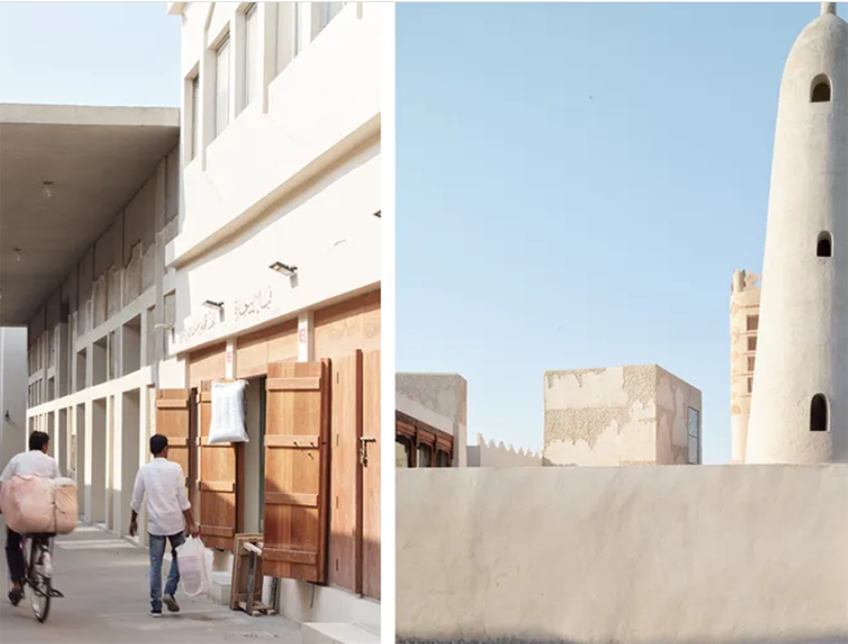
Close

Approach Words: Heritage Preservation, Integrated City, Urban Livability
Public Policy Instruments: Physical Intervention, Planning, Regulatory
The revitalization of Muharraq, the former capital of Bahrain previously known for its pearl industry until 19401, was initiated in the 2000s as a restoration and adaptive reuse initiative under the Sheikh Ebrahim Centre for Culture and Research. This initiative sought to revive the area after it went into decline following the exploration of oil, resulting in loss of pearling trade and displacement of many indigenous people2. The initiative later developed into a comprehensive program entitled “Pearling, Testimony of an Island Economy” 3. The program’s scope of work included the preservation of various sites and buildings, upgrading of building elevations, construction of new buildings, and conversion of vacant lots into public spaces connected through a pathway known as “The Pearling Path”. In 2012, the path was listed as a UNESCO World Heritage site4.
The project aims to promote the area’s pearling history and “cultural tourism in Bahrain, as a way to celebrate the country’s rich culture and heritage, both tangible and intangible”, and hence ensuring a “new environmentally friendly economies”5. It seeks to achieve the following objectives6: rebalancing its demographic makeup, incentivizing local communities to settle in the area families back through environmental improvements, and providing community and cultural venues.

Title: A Map Showing the location of the heritage sites and buildings according to the pathway.
Source: Click Here

Title: Map showing key landmarks of the Pearling Path Project.
Source: Click Here

Title: One of the 18 Public squares in the Pearling Path.
Source: Click Here

Title: Suq Al Qayssareyah (Left) and Siyadi Mosque (Right) after renovation.
Source: Click Here
To carry out the project’s objectives, a ‘Pearling Path’ was proposed7, spanning a length of 3 kilometers in Muharraq City8 and acting as a “living open-air museum”9. The plan for the path is divided into two parts. The first part includes the revitalization of the Sheikh Ebrahim Al Khalifa Centre for Culture and Research, which includes a research library, Nuzul Guest House, Kurar House for Traditional Embroidery, street pavers, and public spaces. The second part includes the Pearling Path itself, and is composed of the following components10:
Pearl Path’s public squares include 17 open space areas with 202 trees, which aims to enhance the experience of the streets and public spaces of Muharraq. They provide residents and visitors with places to gather, rest, and engage in leisure and social activities11 such as traditional music events featuring performances of pearl-fishers’ songs12.
It is worth noting that several laws were introduced to preserve the area’s character and management requirements. For instance, limiting the increase in unplanned construction as well as controlling population, preserving key features in the urban fabric, and protecting sites, settlements, and antiquities. Additionally, the plan designated Bu Mahir seashore and other significant sites as national monuments under Decree Law No. (11) of 199513.

Owner/Developer (Public)

Consultant/Designer

Contractor/Implementer
The project is implemented through a public-private partnership model. It is initiated by Sheikha Mai Al-Khalifa of the Authority for Culture & Antiquities Conservation Department14. The various project sites and elements were designed by different architects including those from the Authority for Culture & Antiquities15. The project elements were implemented by multiple contractors, including Ewan Al Bahrain, General Contracting & Trading, AlMoayyed Contracting Group, Aradous Contracting, and Restaura Srl, each working on a specific part of the revitalization project16. The total estimated cost is $110 million17, including the $26 million for land acquisition to build municipal parking building18. Of this amount, $40million was funded through a loan from the Islamic Development Group (IsDB)19.
In 2019, the Revitalization of Muharraq Project was among the three projects that won the Aga Khan Award for Architecture, where a prize of US$ 1 million was divided among the three winning projects20.
Project Link
Endnotes
N.A.
References